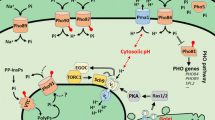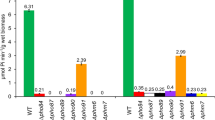Abstract
Wild-type and mutant (glucosephosphate isomerase, pyruvate kinase and respiratory deficientrho) strains were used to determine the kinetics of substrate-induced H+ efflux in dilute suspensions, glucose-induced production of titratable acidity in intact cells and cell-free extracts, and kinetics of extracellular titratable acidity production (pH-stat). The results indicate that (1) initial phases of H+ efflux proceed at the expense of preexisting cell acidity reserves while subsequent efflux is supported by de novo formed acidity, (2) apart from regulation by pHout the H+ efflux is subject to intracellular control, (3) intracellular acidity level is controlled separately from H+ efflux. Tentative scheme is proposed for the regulation of H+ fluxes inS. cerevisiae.
Similar content being viewed by others
References
Borst-Pauwels G.W.F.H., Dobbelmann J.: Determination of the yeast cell pH.Acta Bot. Neerl. 21, 149 (1972).
Duro A.F., Serrano R.: Inhibition of auocinate production during yeast fermentation by deenergization of the plasma membrane.Current Microbiol. 6, 111 (1981).
Galzy P., Slonimski P.P.: Variations physiologiques de la levure au course de la croissance sur l’acide lactique ou sur le glucose comme seule source de carbone.Compt.Rend. 245, 2423 (1957).
Herrera L.S., Pasocual C.: Genetical and biochemical studies of glucosephosphate isomerase deficient mutants inSaccharomyces cerevisiae.J.Gen.Microbiol. 108, 305 (1978).
Moses V., Smith M.J.H.: Uncoupling reagents and metabolism. 2. Effects of 2:4-dinitrophenol and salicylate on glucose metabolism in baker’s yeast.Biochem.J. 76, 585 (1960).
Opekarová M., Sigler K.: Acidification power: Indicator of metabolic activity and autolytic changes inSaccharomyces cerevisiae. Folia Microbiol.27, 395 (1982).
Pascual C., Alonso A., Pérez C., Herrera L.S.: Glucose and fructose consumption in a phosphoglucoseisomeraseless mutant inSaccharomyces cerevisiae. Arch. Microbiol.121, 17 (1979).
Pascual C., Kotyk A.: A simple spectroscopic method for determining proton release from yeast cells.Anal.Biochem. 123, 201 (1982).
Pascual C., Romay C., Sigler K.: Proton extrusion inSaccharomyces cerevisiae mutants in very dilute suspensions.Folia Microbiol.,28, 353 (1983).
Riemersma J.C., Alsbach E.J.J.: Proton translocation during anaerobic energy production inSaccharomyces cerevisiae. Biochim.Biophys.Acta339, 274 (1974).
Sigler K., Knotková A., Páca J., Wurst M.: Extrusion of metabolites from baker’s yeast during glucose-induced acidification.Folia Microbiol. 25, 311 (1980).
Sigler K., Knotková A. Kotyk A.: Factors governing substrate-induced generation and extrusion of protons in the yeastSaccharomyces cerevisiae. Biochim.Biophys.Acta643, 572 (1981a).
Sigleb K., Kotyk A., Knotková A., Opekarová M.: Processes involved in the creation of buffering capacity and in substrate-induced proton extrusion in the yeastSaccharomyces cerevisiae. Biochim.Biophys.Acta643, 582 (1981b).
Author information
Authors and Affiliations
Rights and permissions
About this article
Cite this article
Sigler, K., Pascual, C. & Romay, C. Intracellular control of proton extrusion inSaccharomyces cerevisiae . Folia Microbiol 28, 363–370 (1983). https://doi.org/10.1007/BF02879485
Received:
Issue Date:
DOI: https://doi.org/10.1007/BF02879485




